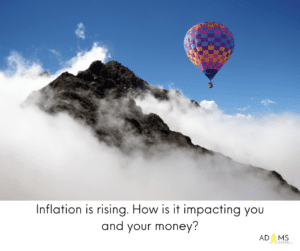Most people don’t think of the cost of a postage stamp and fighting inflation being the biggest risk to their wealth. Nope, it’s obvious any one of the previous six market crashes is more important than how to fight inflation. That’s what we need to be focused on, right?
The dot com bubble that halved portfolios over a 3 year period starting in 2000. The devastation that occurred in the financial markets in 2008 and carried over to it’s ultimate bottom in 2009. Or maybe for you it was the single day in 1987 when it felt like the entire stock market vanished. These are the things that will derail you if we don’t make the right decisions, right?
The Sneaky Truth About Risk
Have you ever thought about the risk to your wealth being what you can’t buy in the future? Those bear markets can definitely take you down but using history as our guide, that’s not the case if you have basic equity diversification.
So what is the biggest risk then?
Past your own emotional investing mistakes, it’s fighting inflation.

Postage Prices and How To Fight Inflation
Let’s look at the cost of a postage stamp to illustrate. In 1989, the cost of a postage stamp was 25 cents. Fast forward to today and it’ll cost you 58 cents for that same postage stamp. That’s more than double.
Now imagine you didn’t get any growth out of your money. Yikes
During that same period of time the S&P 500 which is made up of the 500 leading large companies listed on US stock exchanges with dividends reinvested would have led to over a 10.5% return per year.
That means if you had invested $10,000 in 1990 in a S&P 500 Index fund and reinvested the dividends it would be worth a tick less than $250,000 by the end of 2021. Scary to think about if you made a mistake over that period of time panicking during the multiple “end of the world” market crashes or maybe missing out because you bought the wrong promising Dot.com stock and it failed.
What’s The Real Risk?
Investing mistakes aren’t what I’m trying to point out. Real risk is what we’re looking for and from my vantage point the real risk long term is time outside the markets.
Inflation won’t kill you over a few days or months. It silently eats away at your ability to buy things over time. What makes it worse is you don’t know it’s a problem until it’s too late to do anything about it.
The saying goes, you can’t buy time. While that’s most definitely true, you can most definitely make decisions today that will at least help you to buy more things in the future.
Investing Seems Easy
Okay so what gives? Why then doesn’t everyone just invest in the stock market and problem solved?
From how I see it, that comes down to perspective. We too often get singularly focused on the short term without even noticing it. We mistake volatility with what we’re willing to lose.
The reality is volatility is nothing more than a short term value drop. The flaw becomes that we burn into our brains thoughts like:
“This time if different”
“There’s a bubble”
“Prices can’t stay this high”
All these things are true in the short term but why do we care about the short term? As long as we’re properly diversified in equities, history tells us that equities will not only beat inflation but provide us with additional wealth creation.
Inflation is the real risk. Not participating in the market returns, being under diversified and missing the market returns, watching our ability to buy things deteriorate because we’re paralyzed by the uncertainty of a short term market drop.
How would you feel if you looked back in 10 or 20 years and missed those returns?
The reality is the news outlets aren’t going to talk about the investor that quietly built wealth over a 10-20 year period.
Nope the news is going to show you the guy or gal that became a millionaire in 1 year with $10,000. Or they’ll tell you the story of the investor that lost everything in the most recent market crash.
Fear and greed get clicks. Not long term discipline and sticking to a plan.
-Jarrod Adams
Need Help?
If you have $250,000 or more in investable assets, click the link and get started. Once we learn about your unique situation, we’ll build your custom Asset-Map and visualize your complete financial picture. Get Started


